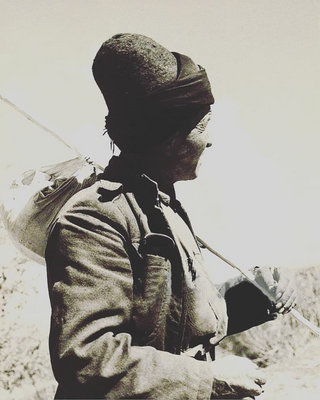Labbadeh
Traditional Lebanese men's headdress From Wikipedia, the free encyclopedia
The Labbadeh[a] (Arabic: اللبادة, lit. '"beaten" referring to the felting process in which it is made'),[1] is a conical brimless felt cap traditionally worn by Lebanese people.[2][3][4][5][6][7]

It is made from sheep's wool and is usually combined with a black scarf during work and with a white silk scarf for celebratory, leisure and formal events.[1][4]
The origin of the labbadeh goes back to ancient times, depictions of it were found in Byblos, Kamid al-Lawz, Aleppo and Tel Michal.[8]
The fashion persisted into medieval times among the Christians of northern Mount Lebanon,[9] where it was especially useful for its natural water-resistance against rain and providing warmth during the cold winters of the mountain. The labbadeh survived into the modern era still being used by some villagers as well as becoming a national symbol of Lebanon as a part of the traditional folk costume of the country.[10]
Etymology
The word labbadeh comes from the Lebanese Arabic word libada which translates to "beat" or "beaten" and is a reference to the beating of wool in the process of making a labbade.[1]
Process
The making of the labbadeh is a hand-made felting process. First, the wool threads must be finely separated from one another before being saturated with soap and water. Then, the wool threads are mixed together again and beaten until they solidify into a labbade. The finished product is then soaked with water and put out to dry.[1][4]
History
The Lebanese[7] Labbadeh goes back to Phoenician times.[2][10][11] Statuettes assumed to be votive offerings have been found scattered across the Levant with the most numerous amount found in ancient Phoenician temples in Byblos where they have since been dubbed the Byblos figurines.
According to the Lebanese archaeologist Maurice Chehab:
A good number of statuettes, placed in these vases, are depicted in full motion and wearing the lebbadé or conical cap, which is still in use in certain regions of Lebanese high mountain. This headdress was held on the head by a chinstrap. One of the ex-votos included several dozen of these statuettes so similar that one can imagine that they represented a troop that would have offered their sponsors [effigies] to the temple before embarking.[12]
The use of the labbadeh for practical purposes began to decline around the mid-20th century.[7] However, the headdress is experiencing a revival movement notably in the village of Hrajel where a workshop has been opened by local farmer Youssef Akiki with the intent of preserving the tradition and knowledge of the labbadeh.[13]
Gallery
- Byblos figurines showing some of the oldest depictions of the labbadeh
- Temple of Hadad within the Citadel of Aleppo with an engraving of two men wearing ornate forms of the labbadeh
- Statuette of a deity wearing a labbadeh, found in Tel Michal
- Evolution of the labbadeh throughout time
- Two Lebanese village boys watching the sunrise. The boy sitting is wearing a labbadeh while the boy standing has on a tarboosh, c. 1920s
- Peasant from Btalloun wearing typical mountain headdress. Oil on canvas by Khalil Saleeby, 1926
- The Oil Seller. Oil on canvas by Moustafa Farroukh, 1934
- A Peasant from the Bekaa. Watercolor paint by Moustafa Farroukh, 1937
- Portrait of a Lebanese villager. Oil on plywood by Moustafa Farroukh, 1939
- Portrait of a muleteer. Oil on canvas by Moustafa Farroukh, 1946
- Conversation by Saliba Douaihy
- Brazilian football star Pelé wearing a labbadeh during a visit to Lebanon, 1975
- Phoenician traders on the coast of Britain by Frederic Leighton
See also
- List of hat styles
- Baalbeck International Festival
- Tantour, traditional Lebanese women's headdress
Notes
References
External links
Wikiwand - on
Seamless Wikipedia browsing. On steroids.













